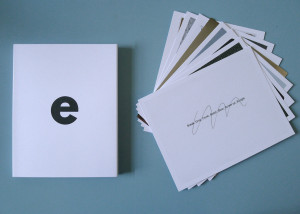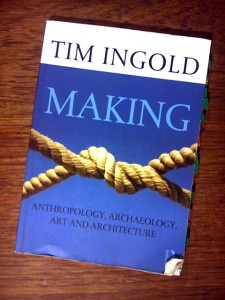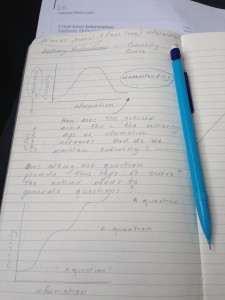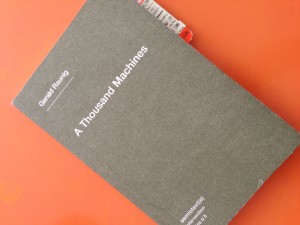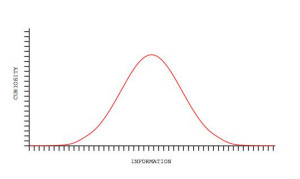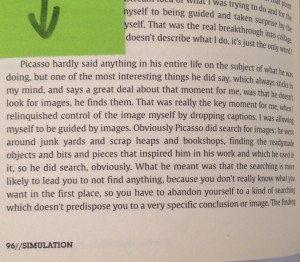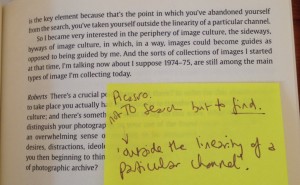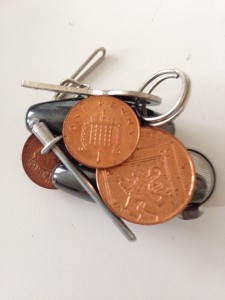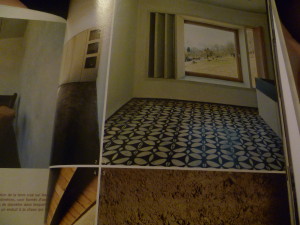We are sitting at the table right now. We are exciting by how the blog is working but struggling with its lack of simultaneity/equivalence. The problem is its linear reading, its sequence. We want to see the thoughts, ideas and references piled up, laid out, swapped round. There is equivalence here to e (the resource produced for the Boetti retrospective) but did e do something that this blog can’t do? Can Noticer do it?
Messwork
In Thinking Through Making Ingold talks about some of the concepts from his recent book Making: Anthropology, Archaeology, Art & Architecture
He says we should have a world of loose ends. We should have meshwork, rather than network, a tangle.
Thinking on from Fischli & Weiss’s can of worms or Hannah Arendt’s pandora’s box, the convoluted tunnels of the philosophers stone or the crest of Huberman’s wave…is there a necessary messiness to the anticipatory, curiosity driven Noticer; a Messwork ?
This reminds me, we must post something on our thoughts around editing…
The Curiosity Curves
What is the relevance of thinking about this as a machine?
We have at times referred to the Noticer as a machine. Why have we considered it in these terms?
Jo’s reservations about the machine as ordered (sequenced), not allowing for chaos seem relevant. The Noticer has to allow for chaos.
According to Raunig in A thousand Machines the machine used to be conceptualized as a “complex composition and an assemblage that specifically could not be grasped or defined through its utilization” p19 The machine as a technical, ordered object only emerged later.
Noticer – a machine for noticing
Curiositer – a machine for being curious
The machine is produced, it produces and it draws labor to it in its construction and its upkeep.
Marx in the ‘Machine Fragment’ doesn’t see the machine as purely technical or as purely a non-living thing but as consisting of numerous mechanical and intellectual organs (A Thousand Machines p22). The machine is not simply a way to ease humans working conditions. Marx suggests humans become a “means” to the machine. Humans preserve the machine from disruption, they use their intellectual and cognitive labor to make it and they operate it.
Does the noticer keep noticing whilst we are not there?
The machine moves from being a tool (an aid) to the machine as a composite apparatus that dominates the labor force. The machine becomes an object that objectifies all knowledge.
The Noticer as a machine – pulling knowledge towards it, producing it and questioning it.
But if there is too much knowledge then curiosity is lost – according to Huberman. So does the Noticer simply generates another question?
Generative – generator – seem important here.
The Noticer is not mechanical, but the machine cannot be seen as simply mechanical either, for Marx it is not limited to its technical apparatus but instead it is a mechanical, intellectual and social assemblage. Knowledge and skills and people are accumulated to it.
Curiosity as a Function of Information
‘I presume few would argue that the experience of art thrives at the top of the bell curve in a place of speculation (and not consensus), hypotheses (and not conclusions) and belief (and not knowledge). To stay at the top of the bell curve, as Buergel and Noack might say, the best art must make us not understand, which corresponds to a state of sustained curiosity that provokes us to change something about ourselves in an effort to understand. To stay at the top of the bell curve, as our diagram clearly shows us, requires stopping information.
Now more so than ever: the efficiency, quantity and immediacy of information and information-systems has placed art and the artistic gesture at risk of being identified, categorised, digested, cannibalised and made into information before it has a chance to begin being art. Curiosity is being castrated by information’.
Anthony Huberman, I (not love) Information, Afterall Issue 16 – Autumn/Winter 2007
We found this through Lizzie the Huberman pusher at Tate. In the context of art school I wonder if it can help us and our students to handle the demand for information and knowledge with care, so as to ensure we’re all surfing at the top of the curve and making great art as a consequence?
In Summer School we are also attempting to stay at the top of the bell curve – yes? If so, how do we maintain curiosity and avoid ‘understanding’? And how do we justify this? How do we avoid a great big fat belly full of information?
Is the clue in the object?
Not to Search but to Find
John Stezaker describes how Picasso did not look for images, but found them, the distinction here suggesting an openness to sources as they present themselves (noticing?), over a search for what you think you want (looking?);
What he meant was that the searching is more likely to lead you not to find anything, because you don’t really know what you want in the first place, so you have to abandon yourself to a kind of searching which doesn’t predispose you to a very specific conclusion or image. The finding is the key element because that’s the point in which you’ve abandoned yourself from the search, you’ve taken yourself outside the linearity of a particular channel.
From
Stezaker, J. (1997) ‘Interview with John Roberts’ in Evans, D. (ed) (2009) Documents of Contemporary Art: Appropriation. London: Whitechapel/MIT Press. p.96-7
Two Magnets
Tricking
In a recent conversation about ways in which artists look in order to find things out as a part of their process of making, Jo shared her practice of looking away from the work and then back again quickly in an attempt to trick herself into seeing anew/again/afresh….the following quote seemed relevant:
‘Closing the eyes can be adopted as a critical operation for seeing that which the retina refuses to acknowledge’
Emma Cocker, Tactics For Not Knowing. Preparing For the Unexpected
Callers to Order
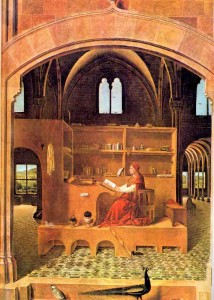
My desk had been cleared. It’s a small, light-colored office model with a chipboard top and steel legs, and it blended nicely with its surroundings. Beside the glass with the sawdust in it, there is an elongated piece of wood with holes at one end, rounded edges, and slanting grooves of varying width–a so-called hand fondler, carved years ago by my son (more or less as a school exercise), blackened from handling, but still smelling of fresh wood, just as the brown, fist-sized, hardened lump of clay beside it, whenever I pick it up, takes on the smell of the damp gully from which it was taken years ago….
All these objects might be termed my “callers to order,” because, by pleasantly diverting me now and again, they save me from losing myself entirely in my work.
My friend Simon gave me Across by Peter Handke a while ago now and this passage about the writer’s desk stayed with me. I think I’m attuned to words about objects. Around the same time I read Thoughts of Sorts by Georges Perec. In it he describes the objects on his desk and the place in which he thinks.
My friend Louisa Minkin made a great piece called The Study of St Jerome after Saint Antonello Da Messina where by an MDF interpretation of the desk from the painting staged performances and artworks by other artists.
Callers to order, philosopher’a stones, desks and writing cases; all are brought together in Brian Dillon’s text for Frieze:
As the novelist Georges Perec – who later composed an essay on the objects on his desk – points out in Species of Spaces (1974), the study is itself a piece of furniture: Jerome inhabits his desk as though it is the cockpit of an interplanetary vehicle, adrift in theological space and time.
Is Noticer an interplanetary vehicle?
Recognition
Where does recognition come in the act of noticing? Do you only notice (rather than look at) something you recognise? You have noticed something because you have been stimulated by recognition. Do we fail to notice things that don’t relate to a set of already present (and waiting to be noticed) connections? What don’t we notice and why?
Yet anecdotally people often say they have started to notice something/s. Can noticing be encouraged/stimulated outside of our already present and waiting connections?
